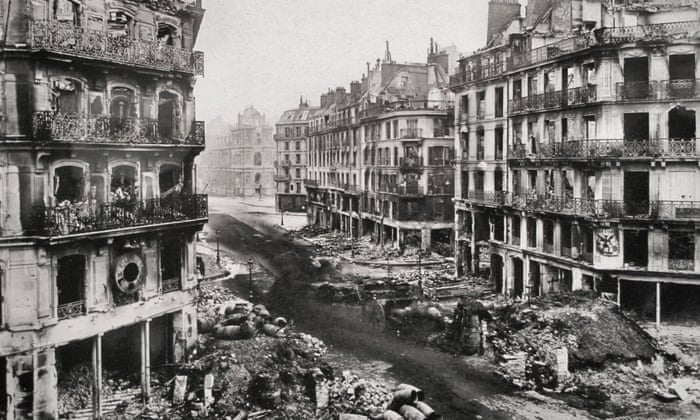The mood in Paris this past week has been nothing short of joyful. Terraces are packed, musicians are playing in the streets, and not even the ever present threat of rain has dampened people’s spirits. Paris is re-emerging after a painfully long winter, and as I walked through the city this weekend, I couldn’t help but smile. I also couldn’t help but marvel at the timing, because this week also happens to mark the anniversary of one of Paris’ darkest chapters in its history. It’s been 150 years since the end of the Paris Commune, and specifically, this week marks the 150th anniversary of what is now known as the Bloody Week.
What is the Paris Commune?
In the summer of 1870, France declared war on Prussia. Napoleon III personally led the French troops into battle, and they were promptly, and decisively, defeated a couple of months later. Napoleon III was captured, the Second French Empire collapsed, and the Third Republic was declared. The newly formed republican government vowed retaliation against Prussia, and Prussia responded by advancing into France and laying siege to Paris. The siege lasted for four months, during which time Parisians were forced to eat the animals in the zoo in order to survive. The city finally surrendered on January 28th, 1871, and an Armistice was signed.
This war was called the Franco-Prussian War, and during this conflict, Paris was defended by the National Guard. Many of these soldiers saw the Armistice and the subsequent peace treaty as a betrayal by their political leaders. Elections were held in February of 1871, and Adolphe Thiers was elected as the first President of the Third Republic. As is common with elections, not everyone was happy with the results. So much so, that eventually, the guardsmen in Paris decided to take matters into their own hands.
The Communards Take Control of the City
On March 18th, 1871, government troops moved to take control of the city’s cannons. In Montmartre, a crowd gathered to prevent this from happening, and as word spread throughout the city, barricades were erected across Paris. By the end of the day, the National Guard had taken control of the city, and a new government had been declared. These revolutionaries (or insurrectionists, depending on who you ask) established a radical socialist government called the Paris Commune. They themselves became known as the Communards, and they had big plans for their fledgling government. In the end, however, they were destined to rule the city for a mere 72 days.
It is interesting to note that the policies of the Paris Commune would not look out of place in modern day France. They advocated for the separation of church and state, equal pay for men and women, the abolition of child labour, and the rights of employees, tenants, women, and foreigners. They supported workers’ right to self management and the abolition of interest on debts. Children were granted free education and food, and orphanages were built throughout the city. The Communards were remarkably busy given how little time they were in power.
The Army Sweeps Through Paris
Ultimately, the Commune was not to last. Paris may have been under the control of the Communards, but the rest of France was still under the control of the Third Republic. In May of 1871, the government made their move. On May 21st, the French Armed Forces entered Paris in the west. Over the following week, they swept across the city, overpowering the Communards and Parisians alike. Fighting broke out in the streets. Buildings were set on fire. Hostages and church officials on both sides were executed. And the neighbourhoods of Paris fell one after another as the army moved east.
The Communards’ last stand was a bloody battle that took place in the Père Lachaise cemetery the night of May 27th. A mere 200 guardsmen held off the army for several hours before finally surrendering. Those who were still alive were lined up against a wall and shot. Today, that wall is known as the Communards’ Wall. The following day, on May 28th, the remaining Communards surrendered, and the Paris Commune was officially over.
The Legacy of the Bloody Week
It is hard to imagine the bloodshed of the Bloody Week. The army recorded 877 killed, 6,454 wounded, and 183 missing on their side. For the Communards, the numbers are still debated. Some historians estimate that 6,000-7,000 people were killed. Others think that number is as high as 20,000. 43,522 people were taken prisoner and marched to Versailles to await trial. Most of them were released before that could happen, but 15,895 were ultimately tried, with 13,500 being found guilty.
And it wasn’t just the human cost. Streets all over Paris, including the Rue de Rivoli pictured above, were reduced to rubble. Entire buildings went up in flames, including the Tuileries Palace, and the city’s archives at Hotel de Ville were destroyed. The events of 1871 bitterly divided the city, and the vestiges of the Paris Commune still inspire activists on both sides of France’s political divide to this day.
And yet, despite all this, the Paris Commune gave way to the Third Republic, the longest in France’s history to date. It led to the Belle Epoque, a series of World’s Fairs, and the Sacre Coeur. Impressionism, literary realism, and the invention of motion pictures. 150 years ago, the streets of Paris saw bloodshed, violence, and destruction. But the city re-built itself. And now, 150 years later, Paris is re-emerging yet again. Not from war, but from isolation. And as I walked the streets this past weekend, I couldn’t help but think to myself. No matter what history throws at it, Paris always manages to re-build itself. Hopefully it always will.
Laura Moore is a professional storyteller who loves history and the many stories that make Paris one of the most fascinating cities in the world. Join one of her signature tours to learn the story of a city.




